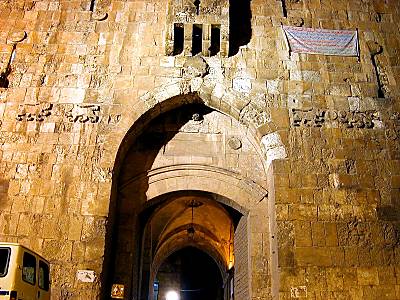
The Lion's Gate (also known as the Sheep Gate):
is located in the east wall. It marks the beginning of the last walk of Jesus from prison to execution, the Via Dolorosa. Near the gate's crest are four figures of lions, two on the left and two on the right. Legend has it that Sultan Suleiman the Magnificent placed the figures there because he believed that if he did not construct a wall around Jerusalem he would be killed by lions.
| |
Israeli paratroops came through this gate during the Six-Day War of 1967 and unfurled the Israeli flag above the Temple Mount.
Herod's gate was built between 1538-40 by Suleiman. Also called the Flower Gate, it is called Herod's gate because early pilgrims thought that it was the gate to the former palace of Herod Antipas. They were wrong but the name stuck. At noon on July 15, 1099, the Crusaders breached the wall at this gate to take the city of Jerusalem and proclaim the Latin kingdom.
Jaffa Gate (also known as David's Gate) is so named because it is the portal for Jaffa Road, the precursor to the modern highway to the ancient port of Jaffa and the Mediterranean coastal plain. Inside the gate is a small square between the Christian and Armenian quarters. Running along the high city walls, south of the Jaffa Gate is the Citadel of Jerusalem (also called the Tower of David). The current tower was built by Suleiman the Magnificent (this guy really was a busy guy!) Legend has it that every conquerer of Jerusalem will enter through the Jaffa GAte. So when German Kaiser Wilhelm II visited
 Jerusalem in 1898, the Suleiman authorities breached the city wall right next to the gate so that he could enter and think he was going through the Jaffa Gate. In 1917, a British general, Edmund Allenby, entered the Old City through the Jaffa Gate, giving a speech at the Tower of David. He entered on foot in a show of respect for the city and a desire to avoid comparison with the Kaiser's entry in 1898. The British demolished other buildings adjoining the city wall in 1944 in an attempt to preserve Jerusalem's historic vistas.
Jerusalem in 1898, the Suleiman authorities breached the city wall right next to the gate so that he could enter and think he was going through the Jaffa Gate. In 1917, a British general, Edmund Allenby, entered the Old City through the Jaffa Gate, giving a speech at the Tower of David. He entered on foot in a show of respect for the city and a desire to avoid comparison with the Kaiser's entry in 1898. The British demolished other buildings adjoining the city wall in 1944 in an attempt to preserve Jerusalem's historic vistas.During Israel's War of Independence, Israeli forces fought hard to connect the Jewish Quarter of the Old City with Israeli-held western Jerusalem by controlling the Jaffa Gate. With a Jordanian victory in 1948, Israeli forces were not able to gain control of the gate until the Six Day War in 1967.
|
|
This is the Dung Gate. It is on the south eastern side of the Old City. The gate leads straight to the Western Wall. The Gate is named for the debris from each consecutive destruction of Jerusalem that was dumped out into the valley below. The walls of Jerusalem's Old City stretch for approximately 2.8 miles and rise to a height of 16-49 feet, with a thickness of 10 feet. Altogether, the Old City walls contain 43 surveillance towers and 11 gates, seven of which are presently open. | | |
| | |
| | |


